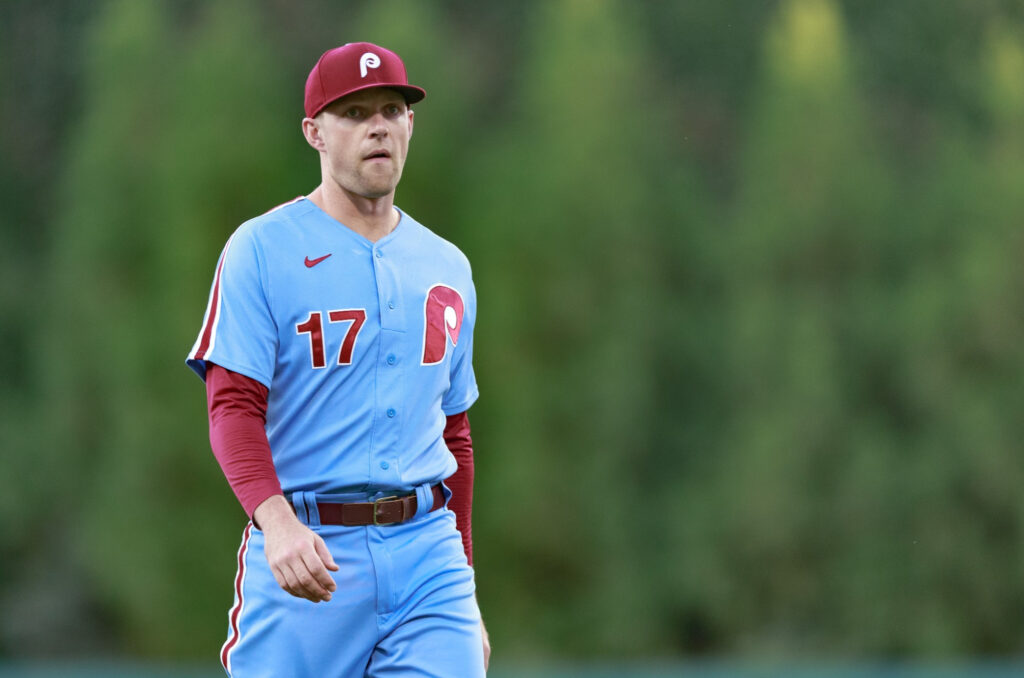

Major League Baseball’s competition committee approved sweeping rule changes Friday set to take effect in 2023. You would be hard pressed to find too many players who are agnostic on the new rules that will come to the sport a year from now.
While the size of bases will increase and pitchers will be limited in the amount of “disengagements” they can have per plate appearance, the two most discussed changes are the banning of drastic defensive overshifts in the infield and the introduction of a pitch clock.
The days of having three defenders on the right side of the infield — perhaps even with one in shallow right field — will end when the 2022 World Series concludes. Beginning in 2023, infields will now be required to have “two fielders on each side of the second-base bag with both feet on the dirt.”
“I mean, I think it’s a pretty split subject depending upon who you talk to, pitcher or hitter,” Rhys Hoskins said Saturday to Phillies Nation. “I tend to lean towards liking it because I think it allows the athletes that we have in this game to be the athletes that they are. I completely understand using the shift as a way to gain an edge defensively. But you’re also just taking baseball IQ instincts — some of the things that we learned as players growing up — you’re taking a little bit of that away with this.”
For Hoskins, there will unquestionably be adjustments to be made defensively as a first baseman when balls are hit to the right side of the infield. But the 29-year-old may very well have a few additional hits per season up the middle with two defenders required to be on each side of the second base bag.
Of course, the hitters who will benefit the most from infield shifts being banned are left-handed ones with power. Ryan Howard trended on Twitter Friday after news of the new shifting rules broke, with many left to wonder how many additional hits the former National League MVP would have had if he played under the rules set to take effect in 2023.
But outside of Joey Gallo, perhaps no one in the sport stands to benefit more from drastic infield overshifts being eliminated than Kyle Schwarber.
“I don’t think you’re gonna ask a left-handed hitter that’s gonna be upset about it,” Schwarber said. “Just because, you’re now taking someone out of the short right field position and you’re putting them on the dirt — now there’s not gonna be three guys standing on that side. So for me, I think left-handers will definitely benefit from it. And I think you’re gonna see the infielders are now gonna be judged a little bit more on range and things like that.
“Am I for it? Absolutely, just because I’m left-handed. But I’m not gonna just be glowing about it. It’s a good thing for left-handers, and we’ll go from there.”
For as much as someone like Schwarber stands to benefit from new rules on shifting, pitchers like Aaron Nola tasked with trying to get left-handed sluggers out no longer will be able to assume that they’ve won the battle when a ball is hit on the ground to the right side of the infield.
“I mean, I guess it’s always good and bad, right? Shifts and no shifts, people get mad when the team is shifted and the ball gets hit through the hole and vice versa,” Nola said. “It will never be perfect, but maybe it will create more balls on the ground more often and guys trying to put the ball in play. I don’t know.”
What Nola does know is that he’s not keen on the pitch clock that will go into effect in 2023, which will change the dynamic he’s had on the mound for his first eight Major League seasons.
“I don’t really like it, to be honest,” Nola said bluntly. “I guess we’ll see how it goes in Spring Training.”
After being successfully implemented at lower levels of the minor leagues, the pitch clock will come to the biggest stage in 2023. Pitchers will have 15 seconds to throw the ball when no one is on base, and 20 seconds with one or more runner on base.
As noted by Hannah Keyser and Zach Crizer of Yahoo! Sports, if the clock expires without a pitch being thrown and it’s deemed to be the fault of the pitcher or catcher, a ball will be called. If the batter is to blame, a strike will be called.
It’s tough to know whether these rules would have been approved if every player in the league voted on them directly. The four player representatives on the competition committee — Whit Merrifield, Tyler Glasnow, Austin Slater and Jack Flaherty — all voted against both the banning of the shift and the introduction of the pitch clock, according to ESPN‘s Jeff Passan.
But ultimately, the player reps were outvoted, and players will be forced to adjust to the new rules in 2023.
“Like all of this stuff, it will definitely be an adjustment,” Hoskins said. “But we’ll just have to learn how to play with these rules in the game.”
Players and fans are creatures of habit. But it’s funny, some rule changes are debated for years or even decades. Many fans and some players made one of their core beliefs for years that the DH shouldn’t come to the NL. Now that’s it’s universal, there’s not too many fans or players longing for the days of pitchers hitting.
“No, I don’t,” Nola said with a smile when asked if he misses hitting. “I do not honestly. I do not.”